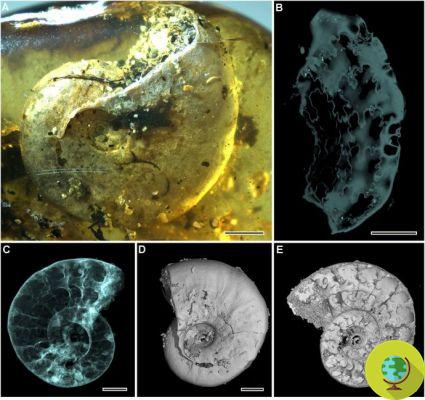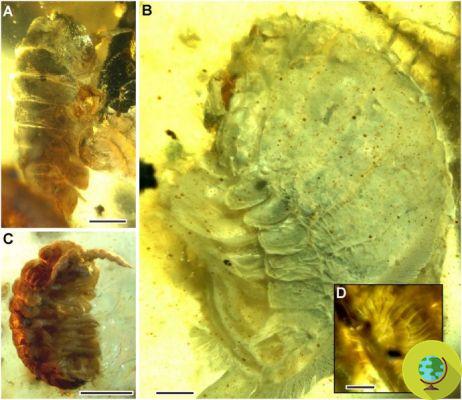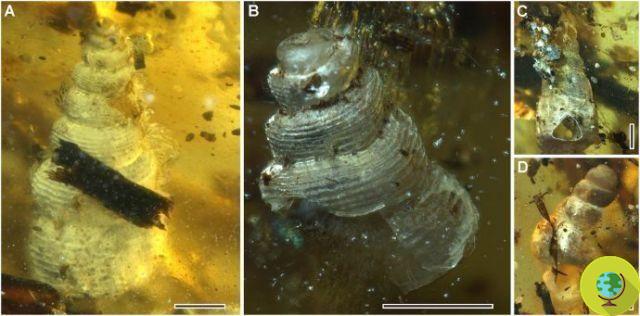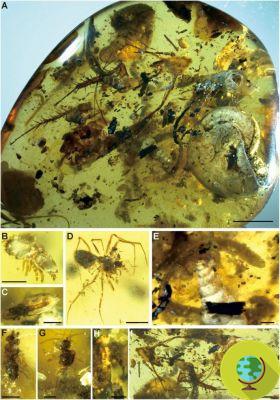It remained for nearly 100 million years encased in tree resin. A team of scientists, led by Chinese paleontologist Tingting Yu, has discovered what is probably the earliest example of an ammonite shell, a marine animal, found in amber on the Earth's surface.
It remained for nearly 100 million years encased in tree resin. A team of scientists, led by Chinese paleontologist Tingting Yu, has discovered what is probably the earliest example of an ammonite shell, a marine animal, found in amber on the Earth's surface.
These are extinct marine molluscs, distant relatives of octopuses and squid that usually did not move on land but lived only in water. For this, find a ammonite shell in a terrestrial fossil it is even more amazing, a bit like the remains of dinosaurs on the seabed would be.
The fossil was found in the present Myanmar and is revealing to scientists a startling insight into life on the Cretaceous shores 99 million years ago. Initially mistaken for the shell of a large snail enclosed in amber, it had been considered common and of little heat but when the collector Fangyuan Xia saw it in the photo he realized that it could contain an ammonite. So he bought it for the Lingpoge Amber Museum, a private museum in Shanghai that he ran. From there the studies started, conducted by the Nanjing Institute of Geology and Paleontology.
Amber produced by trees usually only traps some terrestrial insects and plants but it is very rare to find marine animals, as explained by paleontologist and study co-author Bo Wang.


Researchers suspect this resin came from a tree on the shoreline, which slowly covered an abandoned ammonite shell and other debris as it fell into the sand.
The fossil contains other aquatic snails but also ancestors of mites, flies, beetles, a spider, a parasitic wasp and a millipede. A mix of treasures that has been preserved for millions of years.

“There is a different assemblage (at least 40 specimens) of arthropods in this amber sample from both terrestrial and marine habitats, including Isopoda, Acari (mites), Araneae (spiders), Diplopoda (millipedes) and representatives of the Blattodea (cockroaches), beetles (beetles), dipters (flies) ) and hymenoptera (wasps) ”explain the scientists who used X-ray tomography to obtain high-resolution 3D images.

While ammonite is perhaps the most surprising discovery, the discovery of multiple fossils within the same amber casket is equally exceptional.
"Aquatic organisms are rarely found in amber, but when they do present they provide invaluable evidence for a better understanding of amber taphonomia and ecosystems of the past," the study authors explain. “Our discovery indicates that the Burmese amber forest lived near a dynamic and changing coastal environment. The ammonite also provides evidence to support the age of amber, which is still debated, and represents a rare example of dating using these fossils ”.
Why are admonitions important?
The study is the latest to shed light on ammonites, a group of mollusks that lived during the dinosaur era, with roots dating back more than 400 million years. The group went extinct 66 million years ago along with the dinosaurs but by that time they had achieved global distribution and were very diversified. Like their current mollusc cousins, the ammonite species likely adapted to live at various depths. Some have remained small, about one centimeter wide, others have grown to one meter.
The one identified in amber belongs to the subgenus Puzosia (Bhimaites), which lived up to at least 93 million years ago. Scientists can now use its fossils to estimate the age of marine sediments.
Now that we know that their discarded shells can fossilize in amber, researchers will attempt to locate an ammonite stuck in the resin and stored for centuries.
The study was published in Pnas.
READ also:
- 10 spider fossils found that left researchers speechless (don't open if you suffer from arachnophobia)
- The oldest fossil baby snake discovered, beautifully preserved in amber
- The oldest known animal on the planet has been discovered: it is 558 million years old
Francesca Mancuso


























